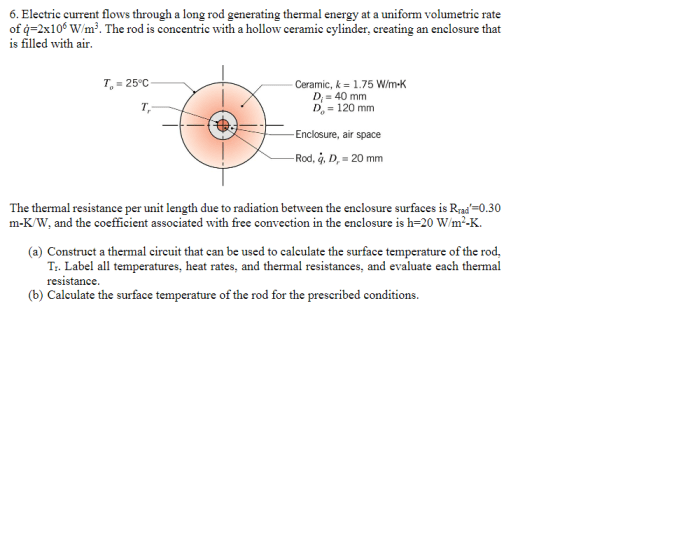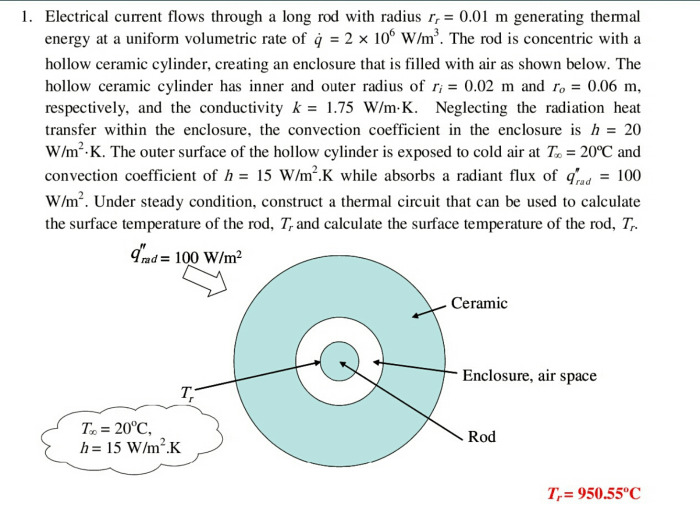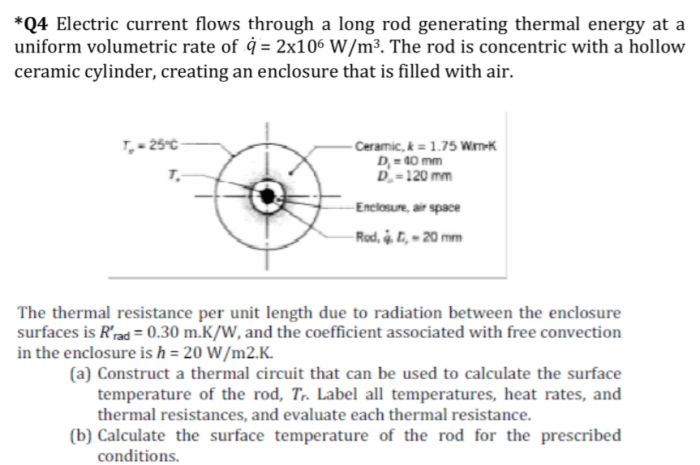Electric current flows through a long rod generating thermal energy, a phenomenon with significant implications in various fields. This article delves into the intricacies of this process, exploring the factors influencing thermal energy generation, its practical applications, and design considerations for optimizing performance and safety.
Understanding the interplay between electric current and thermal energy is crucial for harnessing this phenomenon effectively. This article provides a comprehensive overview of the topic, covering both fundamental concepts and practical applications.
Definition and Overview

Electric current flow through a long rod is a fundamental concept in physics that involves the generation of thermal energy. Electric current, measured in amperes (A), represents the flow of electric charge through a conductor, such as a metal rod.
When electric current flows through a conductor, it encounters resistance, which opposes the flow of charge. This resistance causes the conductor to heat up, releasing thermal energy in the form of heat.
The physical processes involved in electric current flow through a long rod can be explained using the concept of Joule heating. Joule heating refers to the conversion of electrical energy into thermal energy due to the resistance encountered by the current.
As the electric current flows through the rod, it collides with atoms and ions within the material, transferring kinetic energy to these particles. This increased kinetic energy manifests as increased thermal energy, leading to an increase in the temperature of the rod.
Factors Affecting Thermal Energy Generation
The amount of thermal energy generated by electric current flow through a long rod is influenced by several key factors:
- Current strength:The higher the current strength, the greater the amount of thermal energy generated. This is because a higher current leads to more collisions between charge carriers and atoms within the rod, resulting in increased Joule heating.
- Rod material:The material of the rod plays a significant role in determining the amount of thermal energy generated. Materials with higher electrical resistance, such as nichrome or tungsten, generate more heat compared to materials with lower resistance, such as copper or aluminum.
- Rod length:The length of the rod also affects thermal energy generation. A longer rod provides more resistance to the flow of current, leading to increased Joule heating and higher thermal energy generation.
Applications of Electric Current-Induced Thermal Energy, Electric current flows through a long rod generating thermal energy
Electric current-induced thermal energy has numerous practical applications in various fields:
- Electric heaters:Electric heaters use electric current flowing through a resistive element to generate heat, which is then transferred to the surrounding environment. This principle is commonly used in space heaters, water heaters, and heating coils.
- Incandescent light bulbs:Incandescent light bulbs produce light by passing electric current through a thin tungsten filament. The filament heats up due to Joule heating, emitting light as it glows.
- Industrial processes:Electric current-induced thermal energy is used in various industrial processes, such as welding, soldering, and metalworking. In these applications, electric current is passed through a workpiece to generate heat, enabling the desired shaping or joining of materials.
Advantages of using electric current for thermal energy generation include:
- Precise control of heat generation
- Rapid heating and cooling rates
- Compact and efficient design
Limitations include:
- Energy loss due to resistance
- Potential for overheating and damage if not properly managed
Thermal Energy Distribution and Management
When electric current flows through a long rod, thermal energy is generated throughout the rod’s volume. However, the distribution of thermal energy is not uniform.
To prevent overheating or damage, it is crucial to manage thermal energy distribution effectively. Techniques for optimizing thermal energy distribution include:
- Using materials with high thermal conductivity:Materials with high thermal conductivity, such as copper or aluminum, allow heat to dissipate more easily, reducing the risk of localized overheating.
- Incorporating heat sinks:Heat sinks are devices that absorb and dissipate heat from electronic components. Attaching heat sinks to the rod can help distribute thermal energy more evenly.
- Optimizing rod geometry:The shape and dimensions of the rod can be designed to enhance thermal energy distribution. For example, a rod with a larger surface area can dissipate heat more effectively.
FAQs: Electric Current Flows Through A Long Rod Generating Thermal Energy
What are the key factors that affect thermal energy generation in a long rod?
The key factors include current strength, rod material, and rod length. Higher current, lower resistivity materials, and longer rods generally lead to increased thermal energy generation.
What are some practical applications of electric current-induced thermal energy?
Electric heaters, incandescent light bulbs, and industrial processes are common examples where electric current is used to generate thermal energy.
What safety considerations should be taken into account when working with electric current-induced thermal energy?
Potential hazards include electrical shocks, burns, and fire. Proper insulation, grounding, and ventilation are essential for safe operation.

